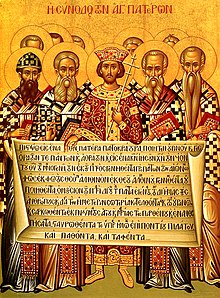
Back Geloofsbelydenis van Nicea Afrikaans የንቅያ ጸሎተ ሃይማኖት Amharic قانون الإيمان Arabic قانون الايمان ARZ Нікейскі сімвал веры Byelorussian Нікейскі сымбаль веры BE-X-OLD Nikejski simbol vjere BS Credo de Nicea Catalan Nicejské vyznání Czech Bekenntnis von Nicäa German

The Nicene Creed (/ˈnaɪsiːn/; Koinē Greek: Σύμβολον τῆς Νικαίας, romanized: Sýmvolon tis Nikéas), also called the Creed of Constantinople,[1] is the defining statement of belief of Nicene or mainstream Christianity[2][3] and in those Christian denominations that adhere to it. The original Nicene Creed was first adopted at the First Council of Nicaea in 325. In 381, it was amended at the First Council of Constantinople. The amended form is also referred to as the Nicene Creed, or the Niceno-Constantinopolitan Creed for disambiguation.
The Nicene Creed is part of the profession of faith required of those undertaking important functions within the Orthodox and Catholic[4][5] Churches. Nicene Christianity regards Jesus as divine and "begotten of the Father".[6] Various conflicting theological views existed before the fourth century and these spurred the ecumenical councils which eventually developed the Nicene Creed, and various non-Nicene beliefs have emerged and re-emerged since the fourth century, all of which are considered heresies[7] by adherents of Nicene Christianity.
In Western Christianity, the Nicene Creed is in use alongside the less widespread Apostles' Creed.[8][9][10] In musical settings, particularly when sung in Latin, this creed is usually referred to by its first word, Credo. On Sundays and solemnities, one of these two creeds is recited in the Roman Rite Mass after the homily. In the Byzantine Rite, the Nicene Creed is sung or recited at the Divine Liturgy, immediately preceding the Anaphora (eucharistic prayer), and is also recited daily at compline.[11][12]
- ^ Cone, Steven D.; Rea, Robert F. (2019). A Global Church History: The Great Tradition through Cultures, Continents and Centuries. Bloomsbury Publishing. pp. lxxx. ISBN 978-0-567-67305-3.
- ^ World Encyclopaedia of Interfaith Studies: World religions. Jnanada Prakashan. 2009. ISBN 978-81-7139-280-3.
In the most common sense, "mainstream" refers to Nicene Christianity, or rather the traditions which continue to claim adherence to the Nicene Creed.
- ^ Seitz, Christopher R. (2001). Nicene Christianity: The Future for a New Ecumenism. Brazos Press. ISBN 978-1-84227-154-4. Archived from the original on 14 January 2023. Retrieved 21 May 2022.
- ^ "Profession of Faith". Vatican.va. Archived from the original on 17 January 2021. Retrieved 15 March 2020.
- ^ "Code of Canon Law - IntraText". Vatican.va. Archived from the original on 24 November 2020. Retrieved 15 March 2020.
- ^ Meister, Chad; Copan, Paul (2010). Routledge Companion to Philosophy of Religion. Oxon: Routledge. ISBN 978-1-134-18000-4.
- ^ Cite error: The named reference
Britannicawas invoked but never defined (see the help page). - ^
 Jenner, Henry (1908). "Liturgical Use of Creeds". In Herbermann, Charles (ed.). Catholic Encyclopedia. Vol. 4. New York: Robert Appleton Company.
Jenner, Henry (1908). "Liturgical Use of Creeds". In Herbermann, Charles (ed.). Catholic Encyclopedia. Vol. 4. New York: Robert Appleton Company.
- ^ "The Nicene Creed - Antiochian Orthodox Christian Archdiocese". Antiochian.org. Archived from the original on 30 January 2018. Retrieved 17 January 2016.
- ^ "The Orthodox Faith – Volume I – Doctrine and Scripture – The Symbol of Faith – Nicene Creed". oca.org. Archived from the original on 5 April 2016. Retrieved 17 January 2016.
- ^ [1] Archived 26 July 2011 at the Wayback Machine "Archbishop Averky Liturgics – The Small Compline", Retrieved 14 April 2013
- ^ [2] Archived 26 July 2011 at the Wayback Machine "Archbishop Averky Liturgics – The Symbol of Faith", Retrieved 14 April 2013
© MMXXIII Rich X Search. We shall prevail. All rights reserved. Rich X Search